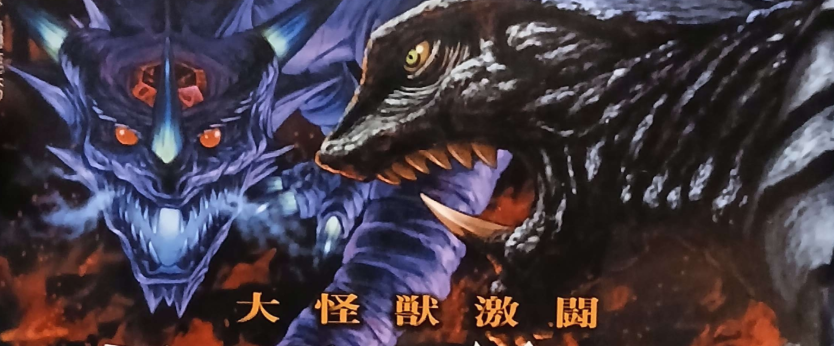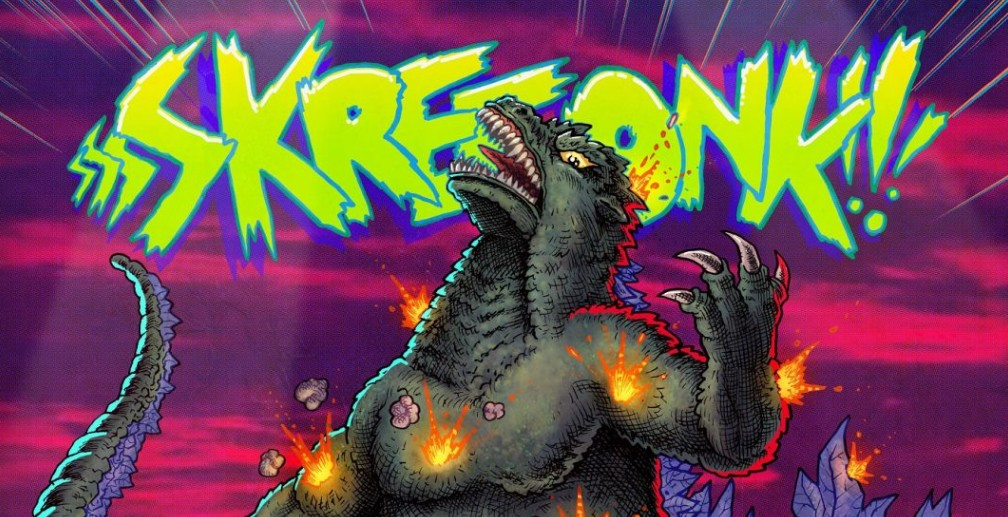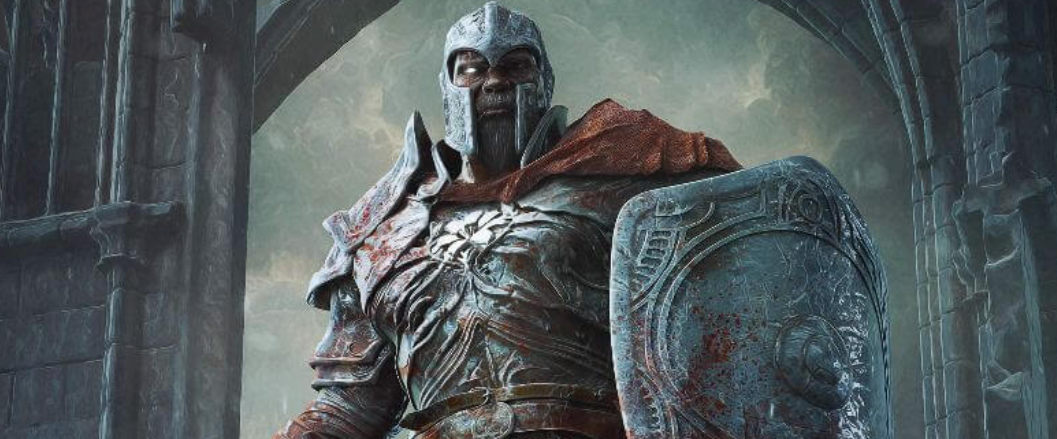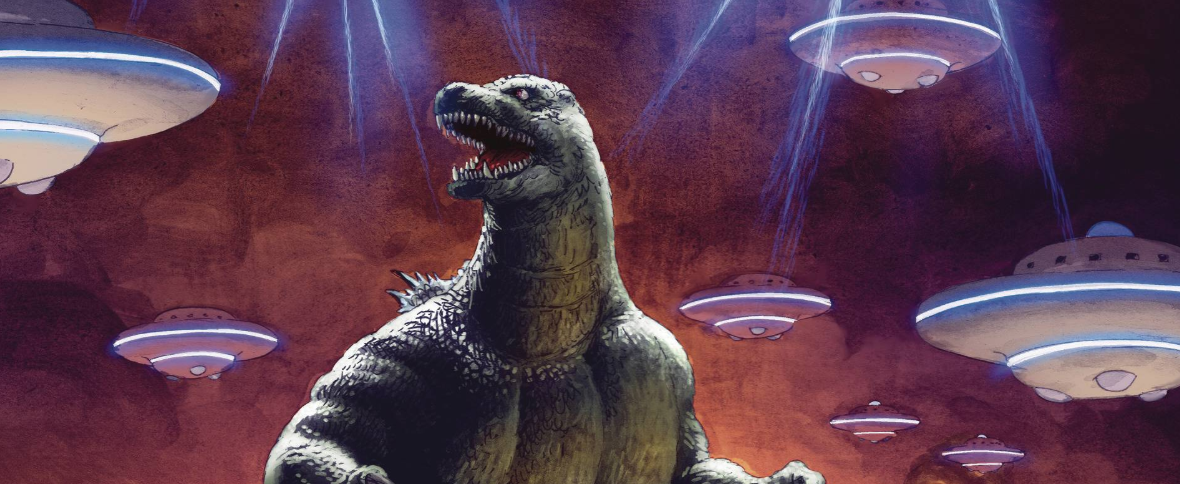Fierce Giant Monster Battle: Gamera vs. Barugon – COMIC VERSION by Kashisu Kondo
It is a popular and frankly valid belief that the greatest daikaiju films are not a collection of Godzilla films, but of the friend to all children Gamera. In the 90s, esteemed Japanese film director Shusuke Kaneko brought forth the Gamera Trilogy which even to this day few can argue against the quality of the groundbreaking genre films featuring the titanic flying terrapin. While the third film, Gamera 3: Revenge of Irys (1999), never got a true sequel due to its open-ended finale of our heroic gigantic turtle standing alone against a massive flock of predatory flying monsters known as Gyaos, little are aware that this necessarily was not the end of the Heisei Trilogy.
In 2003, Kadokawa Comics hired the famed Gundam mecha designer and writer Kazuhisa Kondo to bring to life a direct sequel to Gamera 2: Advent Legion (1996) that serves as a precursor to set the stage of what would be the Revenge of Irys. Once more, not only is this an original (and considered canon) story to the Heisei Gamera Trilogy, it also re-introduces the classic Gamera foe, Barugon, into the pantheon of monsters that Kaneko brought to life in his films. And finally, after all these years, I’ve finally been able to experience this manga properly and I gotta say, this story should be more common knowledge to the fandom.
The overall narrative of Gamera 2.5 is very similar to the original 1966 film Gamera vs Barguon, but it has been molded into the Heisei zeitgeist and adds to the world of Kaneko’s Gamera. The first few pages are a manga adaptation of Gamera’s victory over Legion from Gamera 2 (1996) and the ominous consideration that Gamera is the protector of Earth, not humanity; a distinction that hauntingly makes one realize that if mankind doesn’t change its ways sooner than later, Gamera would view them as a threat no different that the Gyaos.
Sometime later, we are introduced to Kaida, who is a pilot flying two men to a remote island near New Guinea. The first man is a jeweller and adventurer who goes by the name Inoue, who is joined by an archaeologist named Shimomaruko; the two claim that they will achieve riches beyond belief on this island that Kaida is unfamiliar with. When they land, the three eventually come across a cavern system that depicts ancient scriptures that seems to be a lost history between ancient mankind and the giant monsters they created. Much like the original ‘66 film, the men are there to find a rich treasure of precious stones . They do find what they seek, but this treasure shines underneath the vast and ominous skeleton of a long-gone Barugon.
As the greed between Inoue and Shimomarkuo becomes overwhelming at the sight of their fortune, the Barugon skeleton seemingly “cries” a massive opal that intensifies their lust for riches into violence. The greed between these two men quickly overtakes them and leads the story to split into two different directions. Inoue shoots Shimomarkuo and escapes the island on a boat with the massive opal and heads for Japan. Unbeknownst to him, the opal is actually an egg for a new Barugon to be born.
The monster grows rapidly, kills Inoue and using its icy powers, makes its way towards Japan to continue its rapid growth to adulthood, causing destruction in its wake. Kaida is left on the island where he meets a mysterious girl named Aya who seems to hold the key to Barugon’s destruction: a mystical gem that holds the “soul” of the greed-inducing creature. It’s soon a race against time as Kaida helps Aya defeat Barugon with aid of the legendary guardian monster, Gamera.
The usage of Barugon is a welcome sight for the Heisei era canon and blends Kaneko’s mythology seamlessly with Gamera’s Showa era lineage. While the narrative is an almost carbon copy of the original film, its modern day adaptation expands on making Barugon a legitimate threat that gives a preluding sense that while Gyaos are Gamera’s natural enemies, the monsters made before Gamera are more intense threats that will truly challenge our carapaced Guardian of the Universe. Kondo’s design of Barugon is amazing, with its jagged features and imposing presence that upgrades the reptile to be taken more seriously than its Showa era interpretation.

Barugon’s trademark ability of icy breath, weaponized tongue attacks and even the rainbow back beam are all delightfully present in this feature, much to any fan’s delight. What is unique to this story is what Kondo presents with how Barugon connects to humans. While Gamera is benevolently connected with Asagi and Irys’s borderline lustful bond in Ayana; Barugon also seems to crave and be empowered with a connection to humanity. Barugon in this adaptation seems to not just be hungry for gemstones though, as the ravenous monster seems to be unable to just have one person drawn to it.
The self defense forces soon see a slew of peoples following the walking embodiment for the sin of greed as a somewhat primordial cult following begins to grow around the monster’s presence in Japan. Seeing survivors of Barugon become maddened worshippers in the wake of this monster that also serve as human shields for the beast is a fantastic and interesting ability that has been given to Barugon in this story. It makes one wonder what other abilities that the monsters of old would inspire in their human creators.
Speaking of these ancient ones, it is usually expressed in the text you can find about this comic that it explores more of the lore set up in Revenge of Irys (1999) that Gamera and Gyaos were not the only monsters built by ancient civilizations, but that they were mass-produced guardian monsters before they turned on their creators. It is true that this story does explore this worldbuilding a little more in depth than the films do, but it should be noted that it’s still a pretty brief sequence. In an almost blink and you’ll miss it page featured in the first act of the story, Kaida floats listlessly on the surface of the underground lake that is the final resting place for the original Barugon. While unconscious, he soon has dreams of the truth about the monsters that roam his world and it is shown in memorable detail.
At first, these creatures were pets and beasts of burden and took on the forms of mythical creatures like dragons, phoenixes, and even unicorns. Over time though, as wars between different cultures started to wage in this advanced but prehistoric world; these creatures were grown to colossal sizes and used as weapons of mass destruction. As creatures like Gyaos started to turn rogue and bring the civilizations of old to their final days, a last hope was created in the form of what we now know to be Gamera. An interesting collection of easter eggs is presented to us through this flashback, as we are presented with some of the monsters created in the past. Gyaos, Barugon, and Irys make their appearances in the lore of this world, but interestingly in the background we see two other monsters in the form of Zigra and Jiger. This blending of the age shows that even though we only got three movies for Gamera in the Heisei era, there was still a lot one could explore and build into it.
The Showa references don’t stop there though, as one of the more unique features of this manga is that it also explains why Gamera in Advent of Legion is so different from his portrayal in Revenge of Irys. As Barugon is born once again, we see Gamera at the bottom of the ocean feeding off a vein of lava that has broken through the crust of the sea floor. There we see his body physically changing from the two types of suits that refer to Gamera’s Showa behavior of eating flames to get his powers. Kondo being able to work in ties to the original Showa era series of Gamera history into this volume is one of the more captivating features of this book.
The detail of the combat sequences in this volume are also absolutely phenomenal. Kondo illustrates fantastic battles between not just our titular monsters, but the fights between Barugon and the self-defense forces are engagingly action packed. Most of the combat we see in this book is a well balanced mixture of Barugon fighting off the incredibly detailed and well drawn military craft that look anything but generic and the war the spined lizard wages with Gamera. To make it more of an enticing visual spectacle, we even get a fantastic introduction of Gamera’s final form in an absolutely brutal but breathtaking collection of panels where Gyaos appears to hunt fighter jets and is mercilessly taken down by our beloved friend to all children with Gamera’s bare teeth.
The final battle of Barugon and Gamera is a confrontation that makes one lick their lips at the idea of how awe-inspiring it would be to see in tokusatsu fashion. But without the restriction of suit acting, the monsters get to move and fight like real animals, and the two titans here are evenly matched. It is only the help given by Aya and Kaida that gives Gamera a real edge over Barugon and leads to the absolutely intense sequence of Gamera’s final blow on the greedy devil. Even if you can’t read Japanese, the panels that Kondo has drawn for this comic are truly a wonder in daikaiju media.
With all this praise though, this volume does cast a large shadow of elements that don’t really work to the point that it borderline ruins the entire experience that is G2.5. The introduction of Aya, the mysterious woman who holds the key to defeating Barugon, is later revealed to be an almost pointless endeavour. We soon learn that when Kaida starts to interact with other characters when rescued from the island, it’s revealed that Aya may be more or less a figment of his imagination.
This inability to pick a lane with this character makes the final fight between Barugon and Gamera also have less of an impact because in a series of odd circumstances, Aya successfully returns Barugon’s soul all the while being tied up to the greedy reptile’s horn. To Kaida’s horror, he witnesses Gamera blast her alongside Barugon to kingdom come. I feel we are supposed to feel something for this loss but at the same time I kept going, “He’s awfully upset for losing his imaginary girlfriend.”
Once more, the story commits the ultimate taboo of writing by alluding that the entire experience of Gamera vs Barugon was in fact, a dream. This is due to when Gamera achieves this apparent “bittersweet” victory over Barugon and death of Aya, Kaida wakes up back in the cave where all this started and hears an eerie wail in the darkness. I am still thoroughly shocked that for such a solid piece of giant monster story telling, it ends with such a narrative no-no that to be frank, almost ruins the entire experience of this unique piece of Gamera media.
Almost.
Gamera has been around for sixty years and honestly, this is a piece of Gamera media that needs more of a spotlight. Despite its conclusionary shortcomings and odd character work, it is a truly unique experience that not many Western fans seem to know about in the vast history of the iconic monster that is the friend to all children and absolute guardian of the universe. If you want to celebrate the sixty years of high-flying, fire-breathing turtle history in a unique way, try and find an English translation of this text and enjoy!
| Overall Score: 7/10 A truly unique piece of Gamera history that expands the fascinating world of monsters and myth that was brought to life by Shusuke Kaneko. With brilliant art and a captivating story, the only folly this story experiences is its ending. Regardless of that you will still have a shell of a time! |










Very interesting article. Thank you.
Is it safe to assume that this hasn’t been released in the US?
Hey @spookymizu!
This is true. This manga has never been released officially in the USA. There are fan translations out there but nothing official. We hope that changes one day!
Oh! Thanks for the heads up! Lots of fun reading ahead!